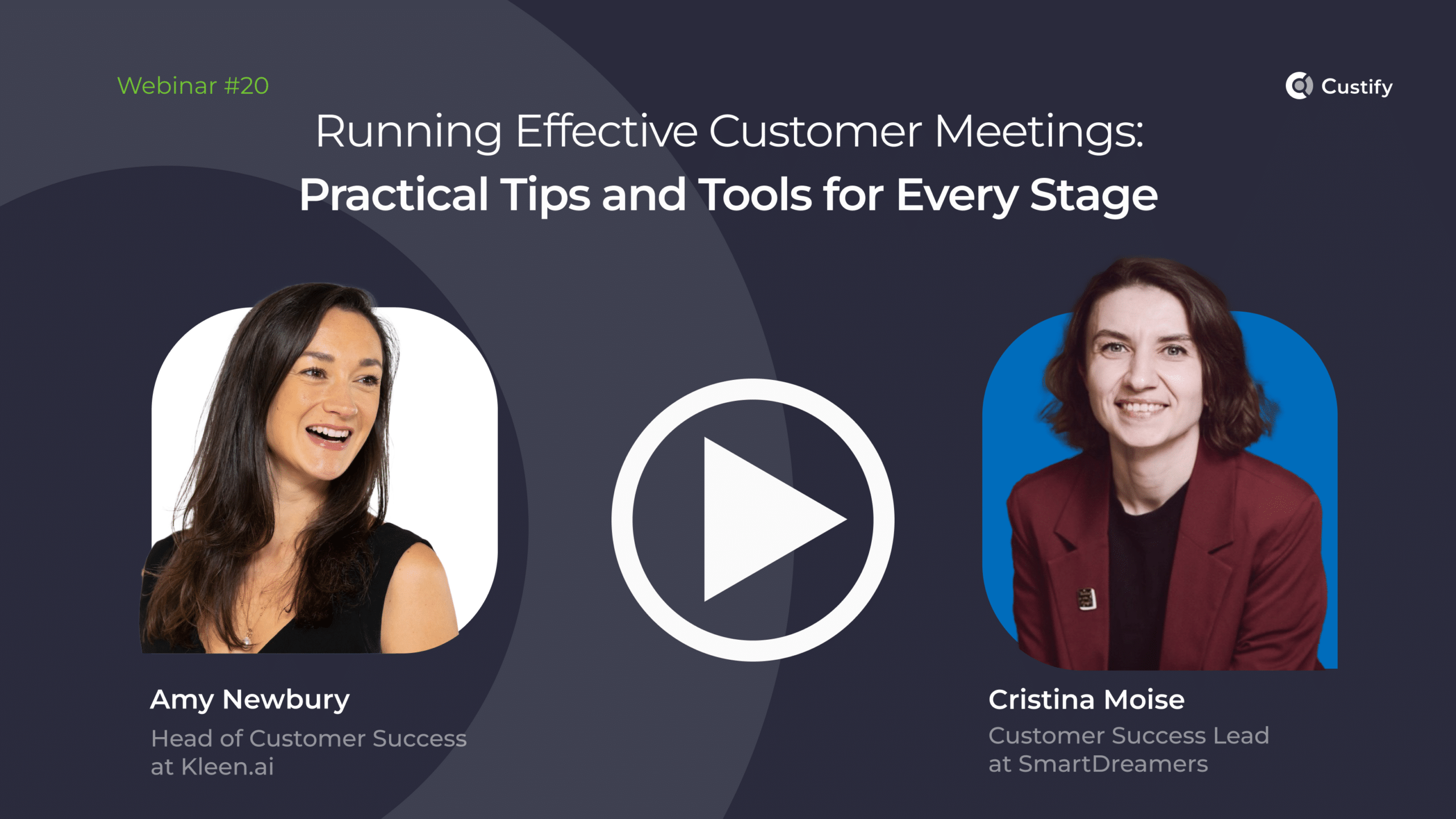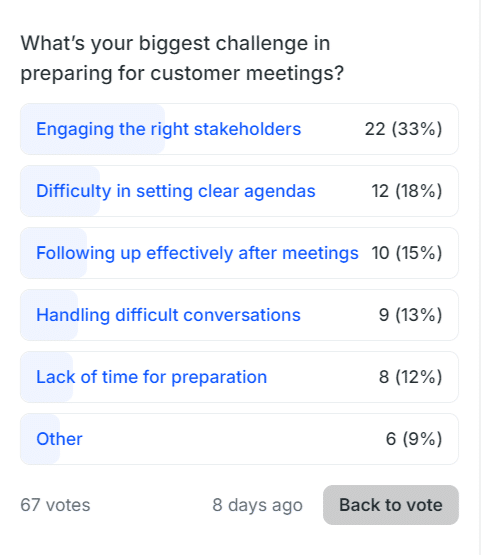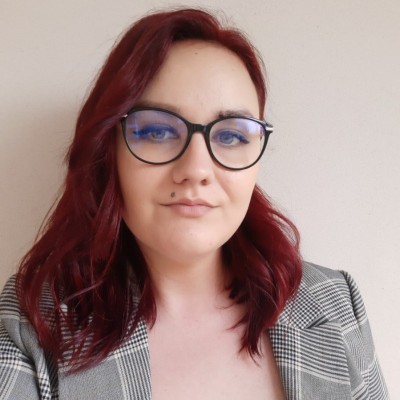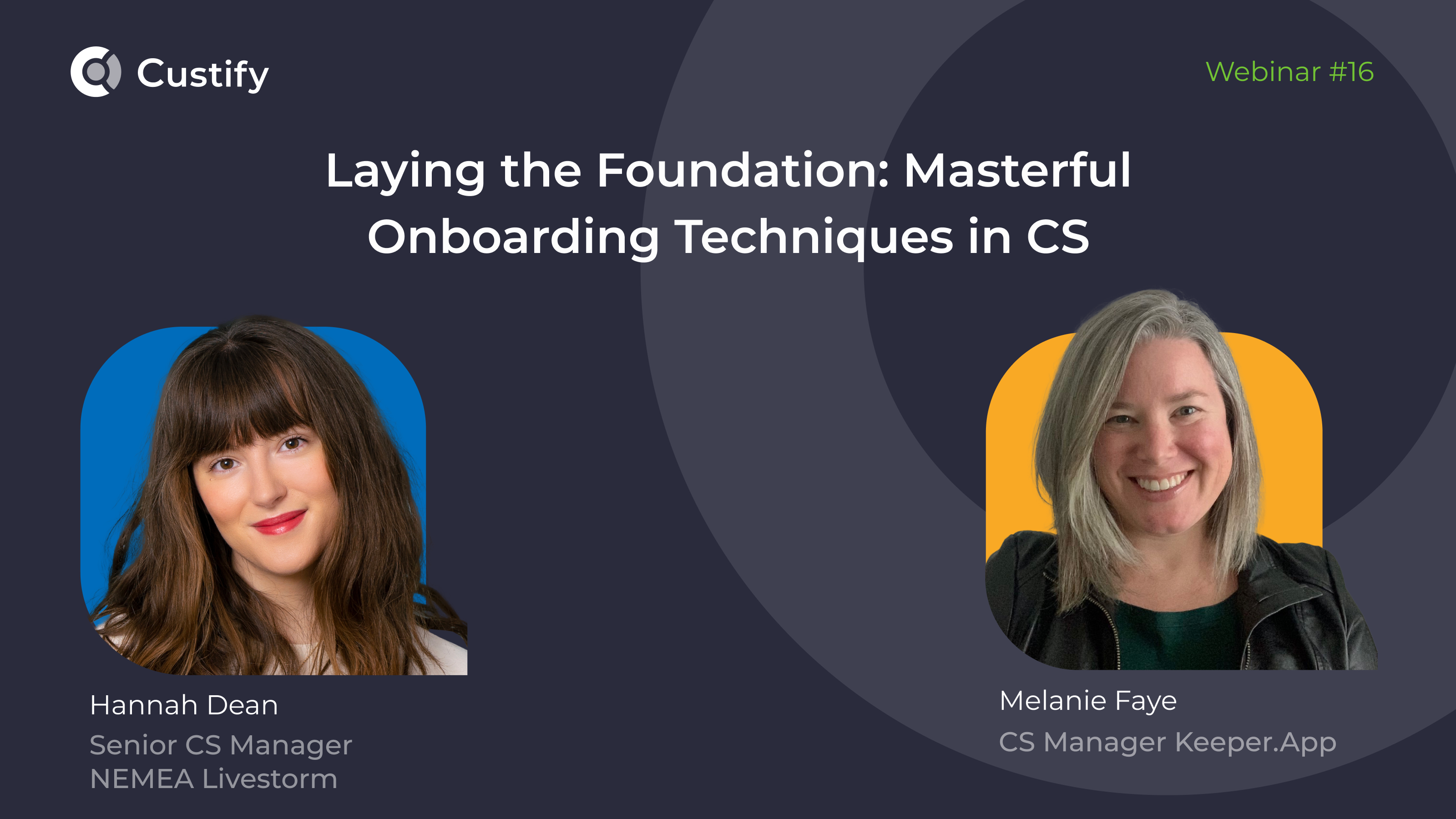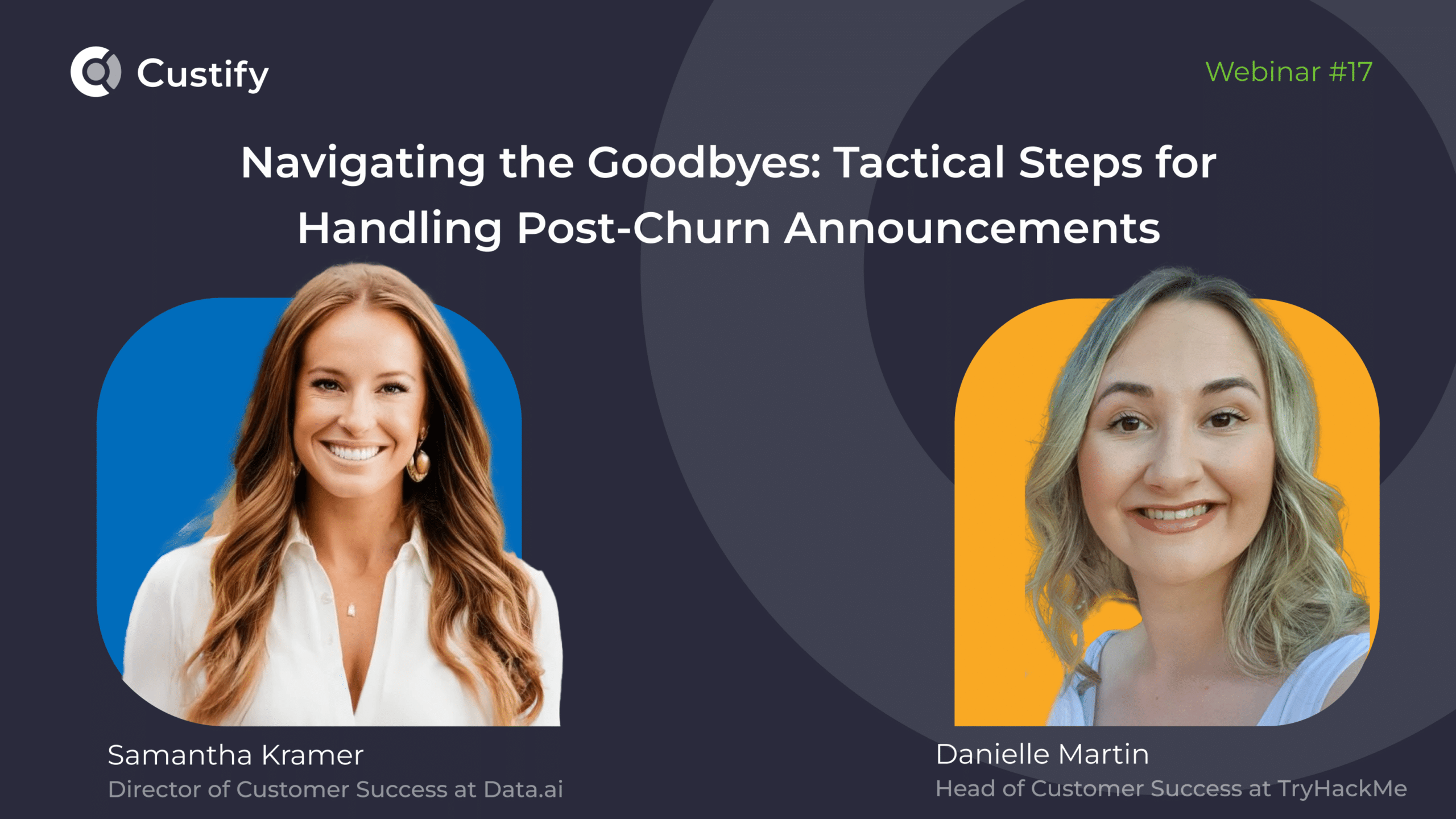In this webinar, Irina Cismas, CMO of Custify sat down with Amy Newbury, the Head of Customer Success at Kleene and Cristina Moise, Customer Success Lead at SmartDreamers. The customer success specialists shared their insights regarding effective customer meetings.
Read on to discover:
- The biggest challenges in preparing for customer meetings
- Prioritizing important aspects of customer meetings when time is tight
- Ensuring the right stakeholders are involved in meetings
- Engaging hard-to-reach decision-makers for QBRs and key meetings
- Deciding between holding a meeting or handling updates via email
- Handling customers who don’t follow CS advice or skip meetings
Summary points:
Effective Customer Meetings: Key Insights and Strategies
In this session, we explored how to make customer meetings more impactful and drive deeper engagement. Here’s what stood out:
- Prep with Purpose: Whether it’s a Quarterly Business Review (QBR) or a general meeting, good preparation makes all the difference. Reusing templates and relying on AI tools can help, but asking direct, open-ended questions to gauge customer needs is crucial for success.
- Stakeholder Engagement: Involving the right stakeholders is key. For routine meetings, include day-to-day users. For strategic meetings like renewals, decision-makers are essential. Use targeted outreach to spark their interest and ensure they see the value in attending.
- Balancing Meeting vs. Email: Not every update requires a meeting. If a QBR can be handled more efficiently via email, don’t hesitate to go that route. If customers start ghosting meetings, that could signal deeper issues, like declining interest.
- Handling Customer Resistance: Sometimes, customers don’t follow the best practices you recommend. Be patient, keep educating, and align your advice with their evolving business goals to increase adoption over time.
- Navigating Team Changes: When your key champion leaves the company, it’s important not to panic. Treat it like a new sales cycle—rebuild trust with the incoming team members, showcasing the value your product provides.
- Measuring Impact: The success of customer meetings is reflected in key metrics like Net Revenue Retention (NRR) and product adoption. Listening to call recordings and reviewing meeting outcomes helps refine your approach and build stronger relationships.
- Collaborative QBRs: Make QBRs a team effort. Involving subject matter experts adds value and reduces the burden on the CSM, while also demonstrating to the client that they have a dedicated team behind them.
Transcript
Irina 00:00
Hello everyone, and welcome! Thanks for joining us today. I’m Irina Cismas, CMO at Custify, and I’ll be your host for this webinar. You know, summer vacation feels like a distant memory now, and we are officially in autumn. And just the other day, I saw a post on LinkedIn that said only three more paychecks until Christmas. And I thought, man, time really does fly, and somehow it’s up to us to decide how meaningful we make it right and for CSMs, that time often gets eaten up by customer meetings, 50% or more, if we are not careful, and that’s why today’s discussion is so important. And I’ve invited two amazing women who know all about making the most of customer meetings. And joining me today are Cristina Moise, Head of Customer Success at SmartDreamers, and Amy Newbury, Head of Customer Success at Kleene.
Together, we’ll explore how to prioritize these meetings, how to prep for them, and most importantly, how to turn them from routine check ins into opportunities for deeper engagement. After all, time is precious, not just for us, but for all our customers and no one wants a meeting that could delete an email.
Irina 01:28
Cristina and Amy, welcome and thank you both for taking the time to share your insights with us today.
It’s actually my pleasure to have you both on stage before we dive into our discussion. I want to cover a few housekeeping items. This event is being recorded, and you will receive a copy afterwards. I know that this is the main question everyone asked. I couldn’t join. Do I receive the recording via email? Yes, you do. Another important aspect. We really value your participation, so feel free to ask all the questions using the question tab or just use the chat function. We’ll try to answer them throughout the session or during the Q&A at the end. You will see me going and looking at the top question. I’m not typing or doing something else and actually checking for the questions. And one more thing, just a big note about us, about Custify. You are probably noticed that time is a big thing today. And of course, no one wants to spend it on repetitive and tedious tasks, and that’s where Custify comes in. And we help you automate those customized success workflows so we can focus on the conversations that really matter, the one that deepen their relationships and drive value.
And without further ado, I want to set the stage for the today’s discussion by hearing from our audience. I think we have almost 45 people who are watching this. We are live with us, and I want to know what’s your biggest challenge in prepping for those customer meetings. And give me a few seconds to actually publish, to actually publish a poll.
Irina 04:19
Please try to actually vote in the poll. I’m curious, actually, which one is the biggest and yeah, it seems that engaging the right stakeholders in this moment is the biggest, but also following up effectively after meetings.
Irina 05:01
So while we wait for the votes to come in, I want to talk about why these challenges do actually matter, and I want to ask you both, what’s the trickiest one? From your perspective, what’s the most difficult one? I’m not sure if you voted it or not, but from your perspective, let’s do a round. Should we start with you, Cristina, and then we move to Amy?
Cristina 05:30
Sure. It really depends on your circumstances within the company. At times, if there are fewer colleagues to support you or if you’re unprepared, handling a customer conversation alone can be challenging, especially with many changes and the need to engage the right stakeholders. As we say in marketing, “it depends.” Personally, for me, the challenge right now is engaging the right stakeholders—not just identifying them, but getting time on their schedules. Meeting fatigue is real; everyone is online with status calls, internal calls, and partner calls. So if you want time for a QBR or an Executive Business Review, you need to be precise, goal-oriented, and deliver value amidst the noise on their calendars.
Irina 06:39
Amy, what’s your challenge?
Amy 06:44
Yeah, I think at the moment, for me, it’s probably lack of time to prepare, but I think that’s just like your classic scale up problem that you have where you’ve got almost like all of the tools, it’s all recorded. It should be super easy, but actually going all the things that happen from one quarter to the next, having tapped that time to really, truly prepare for meetings, is, is, is difficult, and I think we’ll probably be running through some tips later on about how you can overcome that. But I completely agree. I think, depending on where you’re at in a customer’s life cycle, and obviously contract renewals and stuff like that, if you’ve got upsell goals as well engaging those right stakeholders, or trying to impress upon your day to day stakeholders that like, Oh, could you please bring this person with you? Is always going to be really difficult, so it depends on whichever goal you’ve set out for that call, I agree.
Prioritizing the important things in customer meetings
Irina 07:37
I want to rest assure the audience that we will gonna tackle the challenge on how to involve the right stakeholders. Amy, I want to start with you. Actually, when the time is tight, how do you make sure you are prioritizing the most important things for the customer meetings?
Amy 08:00
A lot of it comes down to great templating, to be honest. I often reuse previous material, and we also have AI-driven note-taking that allows you to ask questions, which I find really helpful. Equally, having a strong relationship with your customer—where it’s okay to ask what might seem like stupid questions—can be a great use of time. This approach helps you quickly get up to date with where they’ve been by asking something like, “I know you were working on this last time; where are you at with it now?” That gets them engaged with what they’re currently focused on. It depends on how strategic you want to be in the meeting, but ultimately, if you go in with specific goals, you need to prepare for those objectives. However, if it’s just a general QBR, it’s fine to be more casual and ask open-ended questions, as you’re always going to get useful insights.
Involving the Right Stakeholders
Irina 09:05
I really like that answer, and I would say that there are no stupid questions. So I think we can ask, we can ask whatever, and okay, whatever breaks the ice.
Cristiana, how do you ensure the right stakeholders are involved when it feels like there are so many people to choose from, and it seems to be the number one challenge mentioned by our audience.
Cristina 09:32
It really depends on the size of the client, the number of stakeholders, and the goal of the specific meeting. For example, if it’s an operational QBR with influencers and day-to-day users who want to see progress, but the decision-maker isn’t required because they’re engaged in more strategic discussions, we can align with the team members and send a short QBR or deck over email to save time.
If it’s a more strategic meeting, such as when we’re nearing renewal or exploring an upsell opportunity, it’s essential to involve the influencers and assess the meeting goals to expand the contract. You’ll need to identify the right person and ensure the message is positioned in a way that makes the meeting interesting for them. After reviewing the goals and objectives, conduct discovery sessions to understand what those stakeholders engage with on social media, especially if you haven’t met them before or don’t have a strong relationship.
If there’s a salesperson who has day-to-day contact with them, make sure to involve your colleagues as counterparts during the meeting to validate your points and provide an extra layer of credibility and trust.
Engaging Hard-to-Reach Decision Makers
Irina 11:23
You mentioned that for a QBR close to renewal, it’s important to involve the decision-maker. My question is, what if you can’t reach that decision-maker? In some cases, they may not be interested in joining these types of conversations. How do you spark their interest in attending the meeting and ensure they don’t ghost you?
Cristina 12:03
Yes, typically we go into prep mode. Since we work with high-end, high-touch clients, we need to have a clear list of goals for the QBR. These goals are sent to the decision maker—who may be hard to reach—using multiple channels: email, phone, LinkedIn, and involving the salesperson who has a relationship with that stakeholder, as well as influencers. The idea is to tackle it from various angles to ensure we at least get some feedback. Is it a timing issue? Is it a need for more information? It may not be a lack of interest, but rather the need for further discovery or preparation. We may need to take a step-by-step approach to get them to join the meeting.
When to Decide Between a Meeting or Email
Irina 13:07
You know what? I’m curious. Sometimes a full-blown meeting isn’t necessary, and certain things can be resolved through an email. You’ve mentioned that some QBRs can even be streamlined via email due to time constraints or other reasons. So, I’m curious—how do you decide when something needs a meeting versus when it can be handled with a simple email? Also, are there situations where customers specifically request an email rather than a QBR or face-to-face meeting? And could that be a signal that the relationship is going south?
To be honest, I’ve experienced it myself—ghosting QBRs because I found them to be a waste of time, knowing I was going to cancel the contract eventually. When customers ask for an email instead of a meeting, it can feel like just ticking a box. So how do you make that call between email or meeting, and if you’re ghosted, do you take it as a sign that things aren’t going well? Amy, let’s start with you.
Amy 14:32
I agree. A key signal that things might not be going well is when a client starts disengaging from meetings altogether or when fewer team members participate. However, I think that points to a bigger issue with the QBR process itself. It suggests that previous QBRs weren’t seen as valuable enough to justify their time. That’s where a reset in approach is needed.
We went through a similar phase about 18 months ago, where meetings with customers were more transactional. We’d have monthly or quarterly check-ins without much progress, and it was clear the meetings were just routine “how are things going” discussions. We realized this wasn’t effective, so we put a lot of effort into making QBRs more meaningful, turning them into two-way conversations. These meetings became more focused on understanding deeper business goals, future objectives, and what drives the individuals within those businesses to succeed.
As a result, now we’re at a point where some renewal conversations can be more transactional and handled offline. Since we’ve built a strong foundation with effective QBRs throughout the year, we can offer renewal options via email with the confidence that the customer has been taken through the right journey. Of course, this approach is something we’re currently testing, but the idea is that fewer surprises should come up because the important conversations have already happened during previous QBRs.
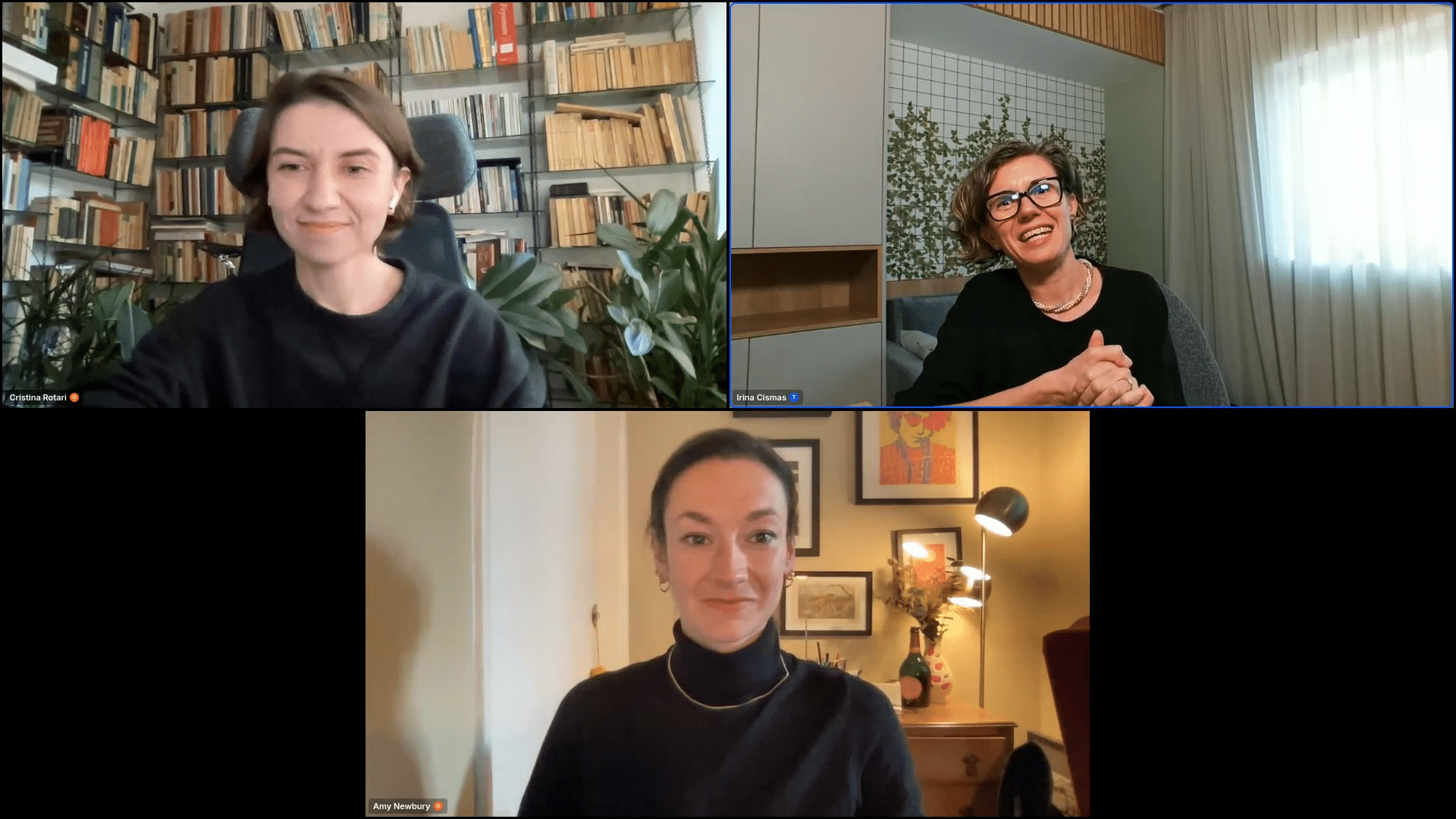
Cristina 16:41
Yeah, I agree the value of the QBR is the key. So unless it’s valuable for both the customer and the business, it’s worth doing. Otherwise, it can be structured in a, I don’t know, weekly, monthly call, and you review the all the three months that were passed. In case it’s a seasonality type of client that don’t have a lot of activity, there is no worth making a QBR because you might get that decline, but it might not be specifically lack of interest. And you should ask yourself, is it my goal just to reach a QBR in my task list, or is it really bringing that value to the client? And, as Amy has mentioned, build up the momentum for the battles that really matter. So in that case, it’s the upsell, the maybe a QBR at the beginning of the year, and setting up some long term goals and QPR towards the end of the year to see how you progressed and the storyline. It’s what matters, not to just ticking the boxes of the frequency.
Handling Customers Who Don’t Follow CS Advice
Irina 17:54
There are some discussions on the chat. I’m also monitoring the tool. I want to address one thing Gizelle mentioned on the topic of progression with customers: it is frustrating when we provide best practices for success, and yet the customer fails to follow CS expert advice, fails to join the meetings. Have you experienced a similar thing when you try to do your best and the customer decides that he knows them all and ignores the interaction? How do you handle this objection?
Cristina 18:54
I think it’s more about setting expectations for CSMs and understanding that not everything will click with the customer on the first try. You can work with a customer for four or five years and still struggle to push certain elements forward. The key is to circle back when the timing is right and continue educating the customer, aligning everything with their business goals. You need to translate success into terms that resonate with their specific outcomes, helping them eventually be ready to adopt best practices. As Lenin said, “Repetition, repetition, repetition”—it’s the key to success. So, repeat the same message in different formats—through writing, QBRs, and recurring meetings—until the information lands when the customer is ready to absorb it.
Irina 19:58
Amy, do you have anything to add? Are your customers more obedient?
Amy 20:06
To a point, we tend to have very technical customers, so for the most part, people tend to be subject matter experts. But I completely feel this, and I think you almost need to remind yourself, when you’re facing this issue, that customer success is part of the sales revenue org as well. And if you think like a salesperson, I love hearing my sales team brainstorm ways to approach customers differently, like saying, “Hey, you’re wearing some of their shoes today, can I take a picture and see if this gets a response?” That’s a silly example, but in customer success, sometimes you have to accept that your approach might not be compelling enough.
Maybe you’re not asking the right questions. If you’re constantly pushing the same message and it’s not sticking, it might be time to change the approach. Instead, ask, “What is your biggest problem this week?” or “What didn’t go so well for you this quarter, and how can we help fix that?” They might mention something your platform can’t address, but they might also say, “We’ve had three people leave, and I’m really struggling to keep up.” Then you can respond with, “Great, maybe we can help simplify things. I can take a little off your hands using this tool, for example.” So, it’s about understanding those pain points better rather than repeating the same message, because clearly it’s not working, and it might take a long time. In the meantime, they might churn.
which I’m
Irina 21:44
Cristina, let’s talk about how the preparation process looks for these types of meetings—for QBRs and EBRs. What are the must-have data points you bring to the table? Not just the data you include in the presentation, but how do you prove that the tool they are using is actually helping them achieve their business goals? And how do you demonstrate your contribution to the client’s business success?
Cristina 21:52
So again, it’s important to assess if this is a new client or a client that has been part of your portfolio for some time. For example, if it’s the first QBR, you must highlight the T-zero moment, from when they started using your services or platform, up to the present, to show that you’ve already delivered value. This helps build their trust, showing them that they made the right purchase and that they are in it for the long haul with you. One of the main goals for this type of QBR is to demonstrate that progression from T-zero to T-one and outline what you expect in terms of product or service adoption. If it’s a new client, you’ll want to be closer to the influencer or the new user—let’s call them the “new kid on the block”—and translate everything into ROI in their language. Whether it’s reducing operational costs, time to value, or some other metric, you should include these points in your presentation.
Customers often don’t have time to do their own market analysis, so if you can include that, it’s something that sticks with them. In my personal experience, they often want the deck and more information when you present these insights. If your business line allows, you should also include competitor analysis, as it’s often an important part of the QBR. Additionally, in the preparation phase, you need to align with internal product teams, understand your company’s business goals, and identify the modules that can drive upsell or renewal opportunities, like expanding to new regions or departments.
If the client is more seasoned, it’s important to compare performance metrics—last year versus this year or last quarter versus this quarter. They might be power users, so adoption may not be the focus, but trends, percentages, and hidden analytics insights could make a difference and help them stay ahead of competitors. In this case, you need to be aware not only of your company’s product releases but also of what’s happening in the market. You don’t want to be caught off guard if a client asks, for instance, about AI capabilities in a particular product. So, it’s essential to stay prepared with up-to-date information about both their market and your industry.
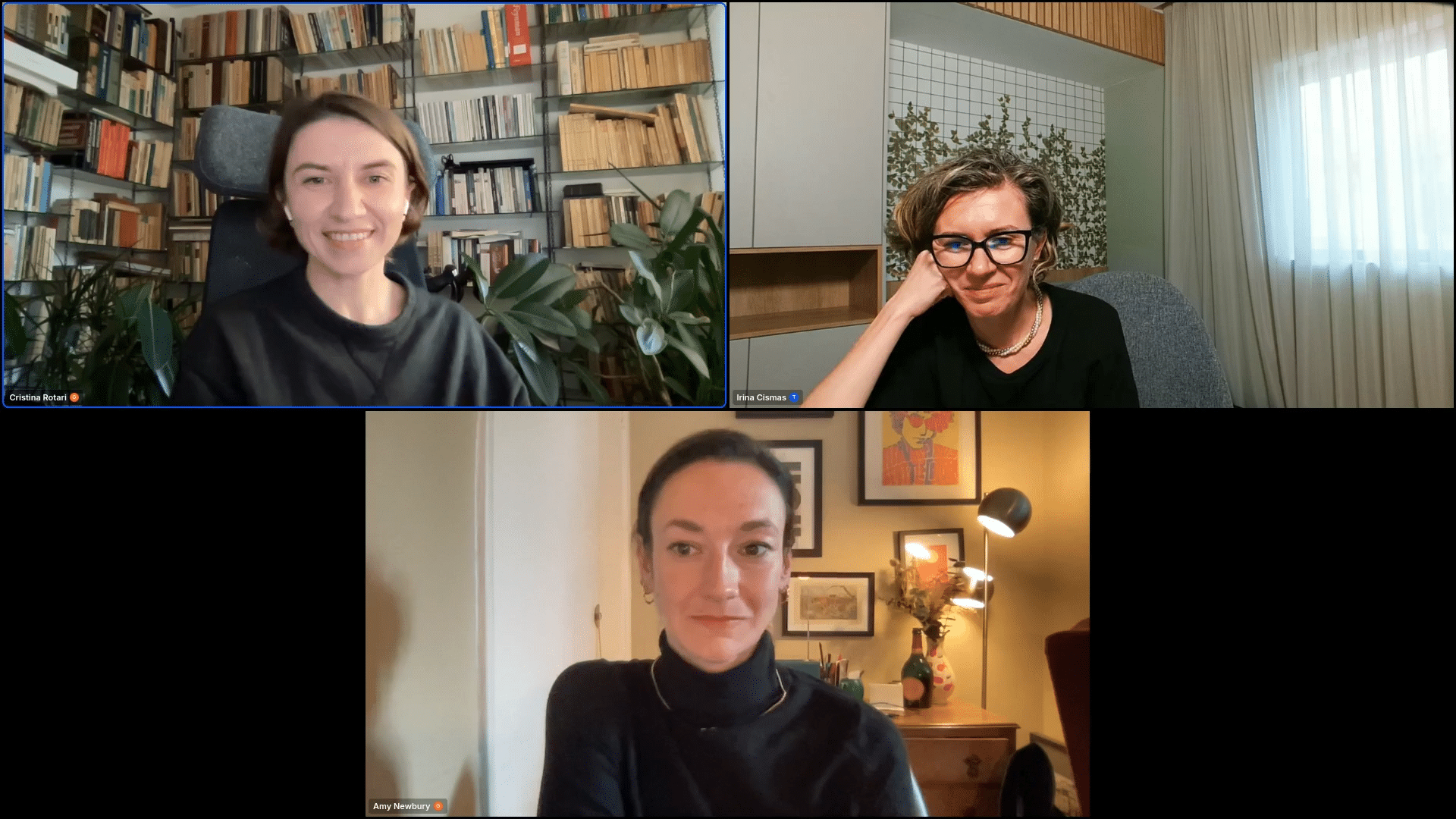
Irina 25:42
I never thought about including market analysis or competitive insights in a QBR—I always focused solely on the business value. I hadn’t considered staying on top of the competition or including product updates. It seems like a 360-degree approach, at least in your case. Amy, how do you prepare for those types of meetings?
Amy 26:12
Yeah, I think in a similar way, you need to constantly be aware of what’s happening, not only in the general market but also within the specific sector of the customer you’re meeting with. It never hurts to do a little research before the QBR. Personally, before entering any QBR, I always encourage my team to take a scenario-based approach. Think about what the best possible outcome for the call could be, and also what the worst outcome might be, and then prepare for both.
I’ve done a lot of coaching with my team and noticed a pattern: when people are caught off guard, they either don’t capitalize on good news or don’t handle bad news well. For example, if a customer says something really positive, they might not know how to turn that into a deeper, more useful conversation, simply because they weren’t expecting it. Similarly, if bad news comes up, they get taken aback and miss the opportunity to address it right away when the information is fresh.
So, if you know a customer has had a good period of adoption, or maybe they’ve raised funding or hired new staff, you should be ready to navigate that positive news. On the other hand, if they’ve been acquired by another company and are consolidating platforms, you need to be prepared to see if you can be part of that conversation and find your way through the situation.
In terms of practical advice, listen back to previous calls, understand the market, and most importantly, anticipate what might happen in the meeting. That’s the best advice I can give for preparing a QBR. The worst situation is going in unprepared and getting blindsided by unexpected news.
Structuring a QBR: Templates and Logic
Irina 28:33
I often hear this question in select CS communities or LinkedIn groups where people are looking for a structure or template for QBRs. And I know the most common answer is, “It depends.” But I want to provide at least some guidance. Now, with what Cristina mentioned earlier—like competitive analysis and data points—I feel the need to ask both of you: What’s your go-to template or structure? How do you include these elements? And, most importantly, can you explain the logic behind the structure and template you’re using?
This is important to me because I’ve noticed that what works for Company A doesn’t always work for Company B. So, if we tell our audience of 50+ people in this webinar, “This is how you should structure your QBRs,” I don’t think that’s the best approach. Instead, let’s give examples but also explain the reasoning. Why did you go with this approach and not another? Is it specific to the product you represent, or maybe the industry you’re in?
I think the logic behind the template and structure is more important than just the format itself. So let’s focus on that. Cristina, let’s start with you, and then we’ll move to Amy.
Cristina 30:28
Well, out of all customer success topics, QBRs are my favorite. It’s been a journey of iteration, as you mentioned, Irina—trial and error at the beginning. Personally, it felt like a lonely journey at first, with a lot of pressure and anxiety around building QBRs. There was always a business goal on the line: making the customer happy, aligning stakeholders, and including the right amount of data. In that momentum, you can lose the spark of joy that Amy mentioned—the moment to ask the right questions. It felt like being a one-person orchestra, which over time became quite challenging. How could I manage to ask the right questions while also handling the deck, the data, and all the details?
After many iterations, we finally reached a point at Smart Dreamers where the process became less stressful by spreading the responsibility across subject matter experts. We take the product, the client, and their goals, then set up a storyline for that particular QBR or EBR. We start with an empty deck and assign sections based on the storyline and agenda. For example, if I’m the one creating the storyline because I understand the customer, I’ll tell Diana, “For this period, I want to focus on the German market and showcase our progress toward this specific goal.” The subject matter expert then takes the data and makes it shine around the outcome we want to highlight for that QBR.
By involving multiple people, two things happen: first, the anxiety around building the QBR is reduced, because everyone is responsible for just a few key elements of the storyline. In my case, I focus on market analysis and competitors from a strategic perspective, while others handle the operational side. Second, once the QBR is launched, it’s not just me presenting. I present my sections, and the rest of the team presents theirs. This allows the team to overcome their anxiety, take pride in their work, and have their moment to shine. We act as emcees for each other: “Now the stage belongs to Irina,” or “Now it’s Amy’s turn.”
This approach has several benefits. First, the client realizes they’re not reliant on just one person; there’s a whole team of knowledgeable consultants they can count on. Second, the team becomes more invested in the client. It’s not just the CSM talking about the client anymore; everyone is checking the analytics and staying involved with the product to ensure everything runs smoothly. It’s a win-win situation—both for the company and the client—because what we’re delivering isn’t just a QBR, it’s a concert where everyone plays a part.
Irina 34:28
It’s super interesting. I always had the impression that the QBR was solely associated with the CSM. The CSM, like the “scientific expert,” goes in and presents, almost like it’s an exam. That’s how I always perceived the QBR—an exam you have to pass in front of the customer.
Cristina 34:55
Yeah, and one last thing to mention: while my colleagues, like Theo or Diana, are presenting, I have those moments to observe the customer’s reactions. I can see if a particular slide or piece of information resonates with them. That’s when I can step in and ask, “Hey George, how are you handling this in your company?” and start generating a conversation. After a one-person QBR, you might just send an email or survey, but those are static responses. You miss out on the dynamic, valuable information that comes up in real-time, like when a customer casually mentions, “Oh, by the way, we’re acquiring a company” or “We’re making some big changes.” These moments are where the truly valuable insights emerge.
Irina 35:48
Amy, now I’m super curious. How do you do it in your case?
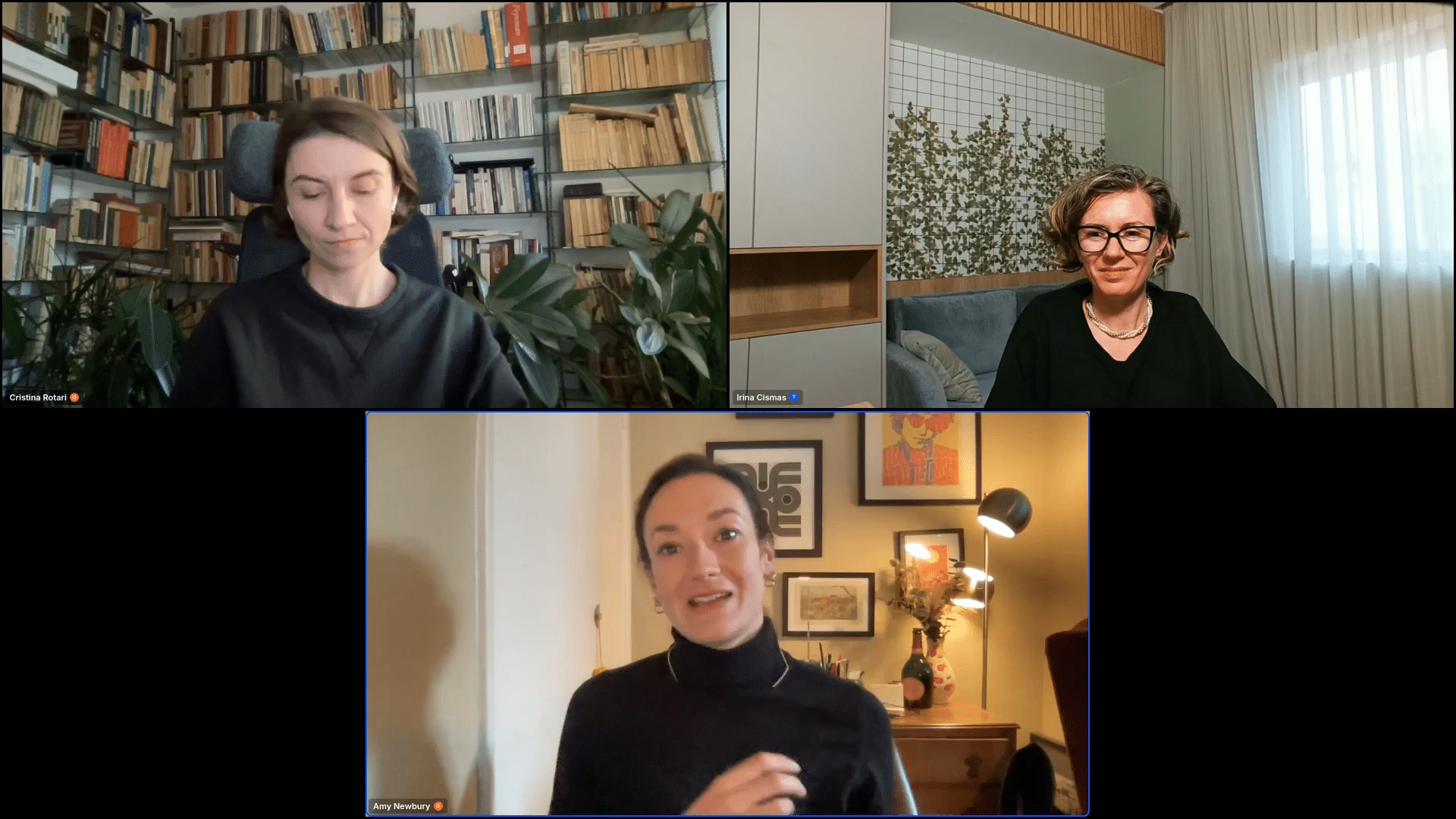
Amy 36:01
Yeah, I mean, Cristina, I definitely want to join one of your QBRs—they sound fantastic. In our org, we also make the process CS-led, but we have the flexibility to bring in the right person as needed. Since there are many people involved in the day-to-day operations, especially given the technical nature of the platform, we have ongoing relationships with support teams and others who handle different aspects of delivery. So, it’s not always necessary to bring everyone into the QBRs. In fact, I tend to use them more as a relationship-building tool with the key stakeholders and as a temperature check on the overall relationship and project status.
I encourage being that central resource, doing the background research—whether it’s talking to analysts about project progress or checking the tech support tickets to understand how issues have been handled—but without necessarily dumping all that information on the customer right away. It’s critical to allow the customer space to speak.
The original question was about structuring a QBR, and we’ve done a lot of iterations on that. Initially, we were pushing too much practical information too soon—like usage data, contract status, and number of data sources—before letting the conversation unfold naturally. It goes back to my earlier point about preparation: by figuring out the best and worst outcomes in advance, you can guide the narrative, even with open-ended questions. You already know where you’re trying to lead the conversation.
When you get to the later stages where analytics, renewals, or issues like declining usage need to be addressed, you’ve already built up a narrative. For example, if they mention their sales director left or they made a platform change, you can reference that context when discussing the harder facts. You might say, “Oh, I’m sure that’s just because of this recent change, and you’ll start using that module again soon, right?” This approach allows the QBR to follow a natural arc.
Difficult conversations, like renewals or declining engagement, become easier because you’ve already proven the value earlier in the discussion. They’ve shared positive insights, like how a new hire quickly adopted the platform, so when it comes time to talk about renewals, and if they claim things aren’t going well, you already have a foundation of good information to counter that. So, I’ve found it’s best to save the hard facts for the end and ensure you control the narrative to guide the conversation smoothly toward those points.
Who Should You Invite to QBRs?
Irina 39:31
That’s a very good piece of advice. And I want to ask you, because it wasn’t actually one of your main challenges. But I’m curious, who do you actually invite in your QBRs, and how do we identify the right stakeholders? I know that Christina answered at the beginning of the conversation. Now I know how do you pick the right people, and who do you Who do you invite? And how do you how do you infiltrate into the organization to find out the right person in your notice?
Amy 40:08
Yeah, I think you’ve got to accept that over time there will be a natural condensation of who joins the QBRs, and it will usually narrow down to the key decision makers on the platform. Whether it’s a head of department or end users, the key responsible people tend to be the ones who stay. If you’re running the QBRs correctly, you should maintain a fairly stable group of attendees. Even if it’s just three people consistently, that means you’re doing a good job.
However, if you need to engage others outside of that core group, you must make it exceptionally clear that this QBR will be a different conversation and why you need that particular person to join. You can’t expect that a new C-level person who just joined the company would automatically find it interesting—more than likely, they’ve already handed it off to someone else. Plus, the head of the department might be proud of the relationship they’ve built with you and might even gatekeep who gets involved.
Don’t worry if your QBRs remain steady with the same group. If you really need to reach out to someone new, just set up a separate conversation. It’s important to have the confidence to approach new executives directly and say, “Hi, I’m so-and-so, and I’m looking after your account. Could we have a quick 20-minute meeting to introduce ourselves?” QBRs have a bit of a reputation for being repetitive, which is no one’s fault, but by creating that back channel with new stakeholders, you can gather valuable insights and weave them into future QBRs based on whatever you learn.
Q&A
Irina 41:59
I want to take a question from our audience. Roxana asked: How can CSM fully digitize MBRs? I think it’s monthly business reviews. Okay, MBR. Do we also have monthly and quarterly? So the question is, how can CSM fully digitize NBRs and QBRs to eliminate the time spent manually preparing PowerPoint presentations?
Who wants to take who wants to take this?
Cristina 42:40
From the digitalization perspective, if you have customers aligned in terms of what they track or do, and your tool supports this with reporting capabilities, you could download specific Excel files and schedule them to populate decks or send newsletters with key snapshots. This can help make sense of the data. However, it also carries a risk because you’re not getting a feedback loop and might be shooting in the dark. With AI and automation, there’s a chance the emails could end up in a spam folder as just another automated message. A safer approach might be to create a reusable PowerPoint template, fill in the numbers from month to month or quarter to quarter, and maintain a structure aligned with the customer’s goals if they’re comfortable with that.
Amy 43:58
Yeah, I think unfortunately, for a customer to be heard, you can’t just ask them the same questions quarter on quarter or month on month, especially so you’ve got to make sure that you are your meetings are responding to whatever it is that they’ve said to you before. And thought like, if you’re just going to do the same thing again and again, that’s when a meeting should be. An email back to the earlier conversation. So why host something if you’re not going to include the nuance from the meeting before is always my my thinking with it, I agree, a really strong template, even like a bank of questions that come up kind of time and time again, or maybe, like, at the start of the quarter, if you’ve got particular objectives that your line manager is pushing for, maybe think of a few, like openly, like open questions that you can include in your QBRs and test them. Say you’ve got a couple in a week. Or, you know, depending on your cadence, three in a week. Maybe say, this week I’m going to test out this group of questions to see if I can get to this outcome and keep the general structure the same. So again, like it depends how you want to work it, but I’d say I would personally never advocate for literally, a copy paste a month on month, because a customer will just stop coming to the meetings and and then they’ll stop engaging with you, and then they’ll probably churn because somebody else, as Christina said, will be breathing down their neck, promising them World Class Cs that they don’t feel that they can get with you. And I think you do only have a certain amount of time to create a second chance if you start to lose that momentum with a customer.
Irina 45:41
I want to there’s remember that I compared the QBRs in those meetings with the exams, and the client is actually the teacher and is assessing your performers. I do have some nightmares from the application part of my life, there is another nightmare that I that I have, not only in QBRs because I’m not a customer success manager person, but I think that those meetings that are happening with no camera and there is no reaction, and you go and you invest A lot of time, and you prepared, and then the customer on the other side is like, Okay, thank you very much. Bye. How do you spark this interest? How do you try to build a conversation when, basically, the customer doesn’t, doesn’t want it, but he is politely showing up in the meeting because he didn’t want you to say.
Cristina 46:52
I think it comes down to personality. In my case, I ask questions and try different approaches—through the window, through the door. Maybe my sales history comes into play here. If I get a one-word answer or no answer at all, I move to the next slide and try again with another added goal. At the end, I ask an open question like, “So what are your current goals, and what are you focused on right now?” I throw the ball into their court to give them the opportunity to answer without me having to guess too much.
I try once, try twice, and if I see them struggling, I ask open-ended questions to bring them back in. There’s a technique where you ask a question, they answer, then you ask another, and after that, you circle back to the first question to elaborate. This helps if their personality takes time to warm up, or if they’re uncomfortable because they don’t fully understand certain metrics or the deck you’re presenting.
You could ask, “Are you familiar with this concept? Do you need more information?” This gives you insight into how to adjust your narrative. Maybe you’re being too technical or too enthusiastic, using terms they’re not familiar with. Even people in high-level roles sometimes need a bit of warming up to open up and engage.

Irina 48:37
I want to give you another, I would say, dramatic scenario—or maybe not so dramatic, as it happens more frequently than we’d like: the champion with whom you built the relationship is leaving, and the meetings were going well up until that point.
To add an extra layer, the champion is leaving, and it’s a new customer with whom you’ve only had one or two QBRs. Amy, how do you keep things moving when the key advocate isn’t there anymore? Do you start from the very beginning? Do you start the selling process again? How do you handle this situation?
Amy 49:39
Yeah, I think there are a couple of critical pieces of information here. Presumably, depending on the contract length, there will be a successor coming into the company. And even if the champion leaves a few months after joining you, if you have a year-long contract, there’s still a decent amount of time to build a relationship with the new person. So, number one, try not to panic. Even if it feels like you have to start over, stay calm—you have time to manage this.
What’s critical at this point is to bring other members of your team into the picture. You need to bring out the big guns. If it requires speaking to heads of product or other key people, you need to really showcase your product and put it center stage. The new person coming in didn’t make the initial purchase, and they might prefer a different platform, which could put the relationship at risk. So you need to be prepared to essentially start a new sales process.
This happens all the time—people change jobs frequently, and it always puts accounts at risk. The best thing you can do is think like a salesperson and put extra effort into the meetings. Make sure the decks are world-class and share any relevant links with the new person, highlighting why your product is effective. Turn it up to 11, and hopefully, the relationship will continue smoothly after that.
But in these cases, you also need to prepare for the worst and act quickly to prevent churn, especially if they weren’t fully convinced about your product from the start.
Irina 51:52
Because I also want to be mindful of time, and we only have eight more minutes, there was a question in the chat. I think you covered it, Cristina. Alice asked, “How do you encourage clients to contribute?” I would say it’s through constant questioning, asking questions that build on each other. Do you feel the need to add more or summarize it, just to make sure Alice got her answer?
Cristina 52:26
Sure. So, practically, open questions are key. When you have a deck with different sections, prepare questions for each section to keep the audience engaged. Don’t leave the Q&A until the end because people might forget the first few slides. Instead, after every three slides or so, ask a question and make sure the client responds.
Another good approach is to send the agenda beforehand and ask if they’d like to present something—maybe company updates or specific elements. This way, they can also take responsibility for part of the QBR. We’ve had cases like this, and it worked well.
Also, don’t run the QBR alone. Even if you have a colleague in “listen mode,” they can share the screen for you, which frees you up to focus on asking questions and observing reactions. Often, when you share your screen, you lose visibility of the attendees’ faces, so having someone else handle that can help you stay engaged with the audience.
Irina 53:48
I know both of you mentioned that these types of meetings went through iteration after iteration, and there wasn’t a bulletproof plan from the start. What you’re using today is the result of multiple rounds of iteration. So, I have to ask: how do you measure the impact of these QBRs, EBRs, or NBRs?
What are your KPIs, and what metrics are important? How do you decide what needs to be changed for the next one? That’s a question for both of you. Amy, we’ll start with you, and then I’d love to hear what Cristina has to say.
Amy 54:37
Sure, I think if I start really simply and then get a bit more nuanced, the basic fact is that if you’re having effective customer meetings, you’ll see that reflected in your retention metrics. The overall company goal is probably net revenue retention (NRR) or something similar, and that’s a long-term indicator of how well customers are responding to the product and your interactions through QBRs. Tracking usage data also helps predict behaviors.
On a more nuanced level, it depends on the company, but we use call recording tools, which give insights into how engaged people are during meetings. They also allow you to review the meetings by listening back. I know most people hate listening to their own calls, but if you speed it up and listen while doing something else, like washing up, it’s easier. You might catch yourself thinking, “Why did I say that?” or “My intro was awful.” There’s a human instinct to forget what we’ve said, but if you confront that and coach yourself, you can improve your performance over time.
Cristina 56:01
Yeah, I totally agree—relying on technology to improve yourself is key. And, at the risk of being repetitive, you might come out of a QBR thinking it went great, but having someone else give you critical or constructive feedback is invaluable, especially since client engagement can sometimes just be polite.
Aside from the subjective engagement rate and answering questions, it’s important to look at the goals you set for the QBR. For example, if you aimed to present new features and drive adoption of certain tools, you can track whether those were actually adopted by following up with the client after the meeting. You can also have a practical approach—starting a project or setting objectives for the next three months—because the next QBR is coming, and you’ll need to show what was achieved compared to the previous quarter.
So, having those next steps clearly defined and ensuring they’re delivered upon is one of the key metrics we look at.
Irina 57:27
Time really does fly, and we are almost at the end of our session. I want to thank everyone for joining us today, and I hope you found some valuable takeaways on how to make your customer meetings more effective and impactful. A huge thank you once again to Cristina and Amy for sharing your insights. It’s been a pleasure having you both with us today.
Before we go, just one last reminder about Custify: if you’re looking to save time and focus more on building the real connections we’ve been discussing today, we’re here to help you streamline and automate those repetitive tasks so you can do just that—build meaningful relationships with your customers. Once again, thank you everyone. Have a great rest of your day, and we hope to see you at our next session!
